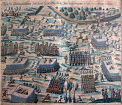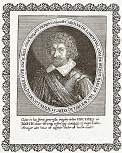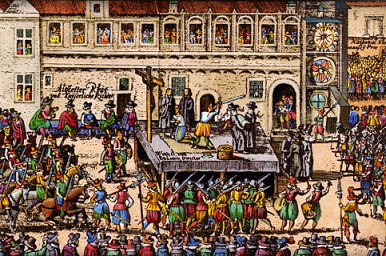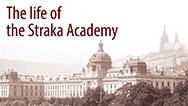Important days
12. 11. 2010
Battle of White Mountain 8 November 1620
During the night from Saturday 7 November to Sunday 8 November sounded, in the dark of a small village of Ruzyně near Prague, shots and clangours of arms. Cavalrymen of the imperial army assailed the Hungarian cavalrymen who belonged to the army of Czech estates and were having their rest there. Those who managed to escape let on the spot not only food, horses and money but also two hundred of killed comrades-in-arms. In the encampment of the Bohemian army caused the survived Hungarian soldiers a fuss. Because of fears of the oncoming battle, they lined up in a battle formation. They had not got their mercenary pays for more than two months and so their urge to fight was not very strong.
After dawn the foot of the hill was covered by a dense fog which shielded the imperial soldiers during their crossing of the Litovický stream. When the fog vanished after nine o'clock, the two armies stood facing each other – the imperial and the Bohemian troops were ready for the fight. It was Sunday 8 November 1620, the Four Crowned Martyrs Day, and on the slopes of the White Mountain a denouement of a great drama was drawing to a close, a drama the first act of which had taken place nearly two and a half years ago.
The story started on 23 May 1618 when the Bohemian delegation of Protestants, outraged by injustice from the side of Catholics, invaded to the Prague castle. Two proconsuls - Vilém Slavata and Jaroslav Bořita were found guilty, by rebels lead by Jindřich Thurn, of breaching freedoms in a trumped-up lawsuit, and according to the old Hussite habit they were, together with scrivener Filip Fabricius, thrown out of the window. Thus so-called heinous rebellion of the Bohemian estates began.
Immediately after the breakout of the rebellion, reorganization of the provincial administration took place. Thirty-member Directorium was established consisting of representatives of lords, knights and towns. At the session of the General Assembly held on 3 July, the constitution was adopted which is also known as the Czech Confederation. As the first one of all constitutional documents issued so far, it was applicable to all land of the Bohemian Crown and it changed the Bohemian state in the federation of estate lands, the unity of which was not secured by a ruler but by the constitution itself. The General Assembly of all lands of the Bohemian crown became the central estate body. Furthermore, the Board of Defenders was constituted and an administrative body of the state became the Bohemian Office in which there were also representatives of other lands of the Bohemian Crown. Ruler, whose powers were limited only to a symbolical function of a head of the state, was elected by all the representatives of all lands; Bohemian representative had two votes and the other one vote. Elected ruler was obliged to respect the provisions of the Confederation and it was forbidden to elect or to crown his successor during the life of the current ruler.
Estates definitely broke up with the Hapsburg monarchy in August 1619 when they got rid of the royal crown of Ferdinand II and when Frederick V Elector Palatine was elected a new ruler. The situation of rebels, in spite of partial military successes – for example the siege of Vienna, was uneasy and estates had no money for paying the mercenary pays. The requests for help addressed to important Protestant rulers remained mostly without response. Only Upper and Lower Austria joined the Confederation; Moravia, on the contrary, did not respond to the request. Military aid was provided only by Pennsylvanian duke Gabriel Bethlen.
On the other side, the position of the emperor Ferdinand II was gradually improving. He managed to conclude an alliance with the leader of so-called Catholic League - Maximilian I Duke of Bavaria and together with him he succeeded in pacifying rebellious estates in Austria. Then the imperial army under the command of Charles Bonaventura Buquoy and the Catholic army under the command of Johann Tserclaes, Count of Tilly trespassed the frontiers and set up to Prague. Although their advance encountered the resistance of still operational Bohemian army, headed by Christian I of Anhalt, they managed to conquer several towns and at the beginning of November they were staying outside of Prague.
On Sunday 8 November, the decision was to be made. Imperial-Catholic army had about 28 thousand men whereas the Bohemian army had about 21 thousand men. Numerical superiority of Catholic troops was partly compensated by better position of Bohemian troops. Moral on both sides was rather poor, imperial soldiers suffered from bad logistics, whereas the Bohemian soldiers had not been given a mercenary pays since September. Also the night massacre of Hungarians in Ruzyně had influence on their willingness to fight. No wonder that no one of rival sides was willing to fight. In particular the Buquoy's attitude to the straight attack against the fortified Bohemian positions was very reserved. Time was passing slowly and when noon was drawing closer it was decided at the briefing of the allied forces to undertake a smaller attack with the aim to bring about a scuffle which was to indicate further advance.
At half past eleven started the first attack on the right imperial wing and after one o'clock the battle was over. Demoralized Bohemian troops gradually beat a retreat. Only one regiment recruited by Moravian estates headed by Heinrich von Schlick remained on the battlefield as the imperial troops hindered it from retreat. Finally soldiers of the "Moravian" regiment were defeated by predominance of enemies and capitulated. Nearly three thousand dead bodies remained on the battlefield; two thirds of them were Bohemian soldiers. Losses were not very high and thus estates could have tried to defend Prague. However, leaders of the rebellion did not find sufficient will and when the so-called "Winter King" speedily left Prague, it was apparent that the estates were defeated. Also some of estate politicians joined the king who was running away; part of them remained hoping that the emperor would forgive them, and they surrendered.
However Ferdinand II did not intend to forgive them and 27 of them saw themselves on 21 June 1621 when their heads rolled down from the blocks at the Old Town Square. Thus, the leading role in the state was definitely taken over by the emperor.










